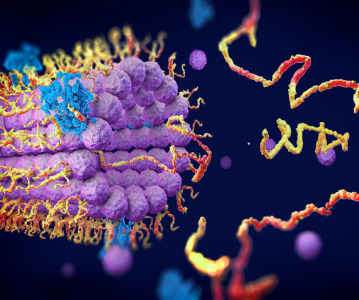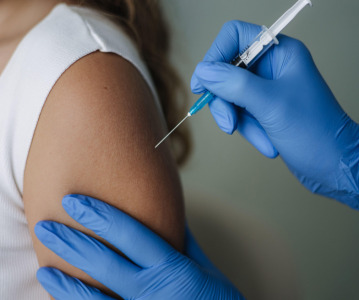Lilly's galcanezumab significantly reduces number of migraine headache days

New results presented at AHS.
Eli Lilly has announced positive results from three Phase III studies of galcanezumab, an investigational treatment for the prevention of episodic and chronic migraine, including late-breaking data on several key secondary endpoints for galcanezumab compared with placebo at both studied doses. Detailed results from these studies (EVOLVE-1, EVOLVE-2 and REGAIN) were presented at the American Headache Society (AHS) annual scientific meeting in Boston.
"The detailed Phase III results represent a crucial step forward for the millions of patients living with migraine who have not yet tried, or found, an effective preventive therapy," said Christi Shaw, president of Lilly Bio-Medicines. "Following more than 25 years of research in migraine, Lilly is excited to help usher in a new era of preventive migraine therapies that may substantially improve the current standard of care for people living with migraine."
The observed safety and tolerability profile was consistent with findings from previous studies of galcanezumab. In these three studies, the most commonly-reported adverse events were injection site reactions.
Based on these results, Lilly will submit a Biologics License Application to the FDA for galcanezumab in the second half of 2017, followed by submissions to other regulatory agencies around the world.
EVOLVE-1 and EVOLVE-2 Study ResultsIn both studies, over the 6-month treatment period, patients with episodic migraine treated with galcanezumab 120 mg and 240 mg doses experienced a statistically significantly greater decrease in the average number of monthly migraine headache days compared with patients treated with placebo, with statistically significant improvements observed at each month starting at one month of treatment.
A statistically significantly greater percentage of patients treated with both doses of galcanezumab achieved at least a 50%, 75% and 100% reduction in the number of migraine headache days compared with placebo over the 6-month treatment period, in both studies after multiplicity adjustment.
EVOLVE-1:
EVOLVE-2:
Patients treated with galcanezumab in both studies also had a statistically significantly greater reduction of monthly migraine headache days with acute medication use compared to placebo over the 6-month treatment period after multiplicity adjustment.
Patients treated with both doses of galcanezumab also saw statistically significant improvement in physical function compared to placebo over the six-month treatment period, as measured by both the Role Function-Restrictive (RF-R) domain score of the Migraine-Specific Quality of Life Questionnaire (MSQ) and the Patient Global Impression of Severity (PGI-S) rating after multiplicity adjustment.
REGAIN Study ResultsOver the 3-month treatment period, patients with chronic migraine treated with galcanezumab 120 mg and 240 mg doses experienced a statistically significantly greater decrease in the average number of monthly migraine headache days compared with patients treated with placebo. Statistically significant improvements for both doses of galcanezumab were observed at each month starting at one month of treatment.
A statistically significantly greater percentage of patients also achieved at least a 50% reduction in the number of migraine headache days compared to placebo over the 3-month treatment period (27.6% for 120 mg and 27.5% for 240 mg compared with 15.4% for placebo, p < 0.001 for both dosing groups) after multiplicity adjustment.
Compared with placebo over the 3-month treatment period, a statistically significantly higher percentage of patients treated with the 240 mg dose of galcanezumab achieved at least a 75% reduction in the number of migraine headache days (8.8% compared with 4.5% for placebo, p < 0.001) after multiplicity adjustment. Patients treated with the 240 mg dose of galcanezumab also achieved a statistically significantly greater reduction in the number of monthly migraine headache days with acute medication use compared to placebo over the 3-month treatment period (an average of 4.3 days compared with 2.2 days for placebo, p < 0.001) after multiplicity adjustment.
Patients treated with 240 mg of galcanezumab also saw statistically significant improvement in physical function compared to placebo over the three-month treatment period, as measured by both the RF-R domain score of the MSQ and PGI-S rating after multiplicity adjustment.
Lilly will submit these findings for publication in peer-reviewed journals in the coming year.
Related News
-
News A Day in the Life of a Start-Up Founder and CEO
At CPHI we work to support Start-Up companies in the pharmaceutical industry and recognise the expertise and innovative angles they bring to the field. Through our Start-Up Programme we have gotten to know some of these leaders, and in this Day in the ... -
News Biopharmaceutical manufacturing boost part of new UK government budget
In their national budget announced by the UK Labour Party, biopharmaceutical production and manufacturing are set to receive a significant boost in capital grants through the Life Sciences Innovative Manufacturing Fund (LSIMF). -
News CPHI Podcast Series: The power of proteins in antibody drug development
In the latest episode of the CPHI Podcast Series, Lucy Chard is joined by Thomas Cornell from Abzena to discuss protein engineering for drug design and development. -
News Amgen sues Samsung biologics unit over biosimilar for bone disease
Samsung Bioepis, the biologics unit of Samsung, has been issued a lawsuit brought forth by Amgen over proposed biosimilars of Amgen’s bone drugs Prolia and Xgeva. -
News CPHI Podcast Series: Why we need to consider women in clinical trials
The latest episode of the CPHI Podcast Series with Lucy Chard covers women's health, specifically women's representation in clinical trials, the associated bias, and the impacts on health for this population. -
News US FDA does not approve MDMA therapy for PTSD, requests more data
The MDMA-based therapeutic developed by Lykos Therapeutics, a California-based Public Benefit Corporation (PBC), has been reviewed and unapproved by the US FDA. The regulator has requested additional phase III trial data for further safety and efficacy... -
News Novartis and Viatris latest facing lawsuit over HeLa cell misuse
Global pharmaceutical companies Novartis and Viatris are the latest hit with a lawsuit claim pertaining to alleged misuse of the ‘HeLa’ cell line from the estate of woman whose cancerous tissue cells were taken without consent. -
News Sanofi invests billions into Frankfurt insulin production site
French pharmaceutical company Sanofi have announced an investment of EUR1.3 billion at their existing BioCampus site in Frankfurt am Main for the expansion of insulin production.
Position your company at the heart of the global Pharma industry with a CPHI Online membership
-
Your products and solutions visible to thousands of visitors within the largest Pharma marketplace
-
Generate high-quality, engaged leads for your business, all year round
-
Promote your business as the industry’s thought-leader by hosting your reports, brochures and videos within your profile
-
Your company’s profile boosted at all participating CPHI events
-
An easy-to-use platform with a detailed dashboard showing your leads and performance



.png)

.png)
.png)
.png)